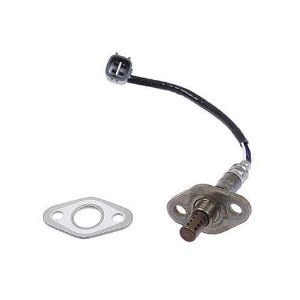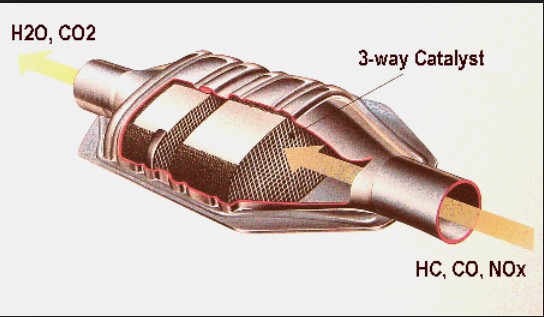P0152 and oxygen sensors
Trouble code P0152 Oxygen Sensor Circuit High Voltage (Bank 2 Sensor 1) is a fairly common code. And like all trouble codes, just because the sensor’s name is part of the description, that DOESN’T automatically mean the sensor is bad. In fact, the sensor could be telling the truth and the real problem might be, and often is, a vacuum leak or a leaking fuel injector. So do your testing before you automatically throw in a new oxygen sensor. 

Speaking of oxygen sensors, you’d better get used to the new technology. The new sensors are called Wideband Oxygen Sensors, Wide Range Air Fuel (WRAF) sensors, or Air/Fuel Sensors (A/F). We’re not just talking semantics here. There really is a difference in how these sensors work.
Old style sensors generate their own voltage
Old style oxygen sensors are literally voltage generators. In other words, they generate their own voltage based on the difference between oxygen content in the exhaust stream and oxygen content in the atmosphere. The voltage ranges from 0.1 to 0.95-volt, with the midway point of 0.45-volts acting as the crossover point. If the sensor reports a voltage below 0.45-volts, the PCM interprets that as lean exhaust, anything over 0.45-volts as rich. However, no computer can accurately calculate the correct amount of fuel as the vehicle is moving—there are just too many variables. You’re always moving the gas pedal, the vehicle is going up and down hills and so the fuel needs are always changing. Since the oxygen sensor is located in the exhaust stream, it’s always measuring how well the PCM did calculating air/fuel mixtures. But it’s always after the fact. By constantly varying the fuel injector ON versus OFF times and watching the oxygen sensor cross-counts, the PCM narrows the “window of errors” to achieve an emissions-friendly reading. And, the PCM “learns” from these calculations and adjusts short and long term fuel trims based on that learning process.
Wideband Oxygen Sensors Work Differently
Wideband Sensors are different because they don’t generate their own voltage. They receive input voltage from the PCM. The reference voltage varies depending on car manufacturer (3.3-volts for Toyota A/F sensors and 2.6-volts on Bosch and GM Wideband Sensors are just two examples). Wideband Sensors still see the swing between rich and lean, but they don’t report it to the PCM as cross-counts. Instead, the internal circuitry varies the output voltage to the PCM.
Both have heaters
In order for the sensing elements to respond to oxygen levels, they must get hot. So the sensors include a built in heater coil. Both traditional and Wideband Sensors have a heating circuit. And just like the older styles, the new Wideband Sensors can develop short-to-ground conditions and failed heaters.
Contamination and leaks
Just like old style sensors, Wideband Sensors can also be contaminated by phosphorous from motor oil, coolant, sulfur, and silicone. And, they’re just as easily fooled by exhaust leaks that allow atmospheric air to enter the exhaust stream.
When a wideband O2 sensor or A/F sensor fails, the symptoms appear almost the same as a conventional oxygen sensor: The engine may run rich, get poor fuel economy and generate higher than normal levels of carbon
monoxide (CO) in the exhaust.
And the causes of the problem may be the same as well–bad wiring connections or a faulty heater circuit relay or a wiring fault, leaky exhaust manifold gasket or leaky exhaust valves.
Most pros check sensor operation with a scan tool. But there are some checks you can perform with a digital voltmeter. For example, you can connect a DVOM multimeter in series with the sensor’s voltage reference line (refer to a wiring diagram for the proper connection). Connect the black negative lead to the sensor end of the reference wire, and the red positive lead to the PCM end of the wire. The meter should then show an increase in voltage (above the reference voltage) if the air/fuel mixture is lean, or a drop in voltage (below the reference voltage) if the mixture is rich.
Be aware:
Honda’s 5-wire “Lean Air Fuel” (LAF) sensor contains a special calibration
Resistor in the connector. If the connector is damaged or contaminated with oil the resistance value will be off.
Saturn also uses a resistor in their wideband O2 sensor connector (pins 1 & 6). The resistor is typically 30 to 300 ohms. The PCM supplied reference voltage is 2.4 to 2.6 volts.
If an O2 sensor, wideband O2 sensor or A/F sensor fails due to coolant contamination, do not replace the sensor until you repair the root cause, or the new sensor will suffer the same fate.
Got a car question? Click here and send it to me. I’ll do my best to get you an answer.
For more information on this repair or any others for your vehicle, buy an online subscription to either Alldatadiy.com or eautorepair.net. Click on this link to compare the two services: Compare Alldata and Eautorepair.
If you just need information for a single repair and want to save money,eautorepair offers a lower price 1-week subscription for only $11.99. Or, if you’ll be working on this vehicle in the future, you can buy a 1-year subscription (Alldatadiy.com for $26.99, or eautorepair.net $29.99)
© 2012 Rick Muscoplat
Alldata and Eautorepair are both professional grade shop manuals. You’ll find more in-depth information and more complete wiring diagrams, along with descriptions of how the systems work. And, you’ll get all that at a price you can afford. Check them out!
Click HERE to read AUTO REPAIR ARTICLES sorted by topic
Click HERE to read some cool DIAGNOSTIC TIPS
Click HERE to read ACURA articles
Click HERE to read AUDI articles
Click HERE to read BMW articles
Click HERE to read CHRYSLER articles
Click HERE to read DODGE articles
Click HERE to read FORD LINCOLN MERCURY articles
Click HERE to read GM articles
Click HERE to read HONDA articles
Click HERE to read HYUNDAI articles
Click HERE to read INFINITI articles
Click HERE to read JEEP articles
Click HERE to read KIA articles
Click HERE to read MITSUBISHI articles
Click HERE to read NISSAN articles
Click HERE to read SUBURU articles
Click HERE to read TOYOTA articles
Click HERE to read VOLKSWAGEN articles



















